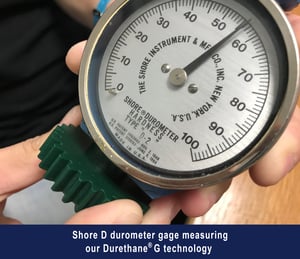Polyurethane Hardness
Hardness is one of many key physical properties to consider while designing with polyurethanes. Unlike metals, rubbers, and plastics – polyurethanes can be custom formulated to offer an extensive hardness range with varying characteristics. In this post, we will explore what hardness is and how this critical property can impact your product’s performance.
What is Hardness
Hardness, a materials resistance to surface deformation, penetration or indentation - Is one of the most critical properties to consider when designing with polyurethanes. Depending on the function of your product, harder materials can oftentimes exhibit better abrasion and chemical resistance, while softer materials may have better flexibility characteristics.
How is Hardness Measured
Hardness, often measured on a Shore durometer scale, is an indicator of a material's resistance to force. The more force or depth of indentation to a materials surface, the softer the durometer reading will be. There are several different durometer scales used to properly measure a materials hardness. However, polyurethanes commonly use only three scales, including A, D, or 00. Shore A and Shore 00 measure the hardness of softer materials, while Shore D measures the hardness of stiffer materials. To help put things into perspective, a gummy bear measures about a 10 shore 00, an inline speed skating wheel is about an 80 Shore A, and a hard hat roughly measures a 70 shore D. Anything harder than a 90 shore D will fall within a Rockwell hardness scale, typically used to measure the hardness of metals.

Hardness Compared to Other Materials
As previously discussed, polyurethanes can be engineered to offer an extensive hardness range from soft, flexible foams to hard, rigid solids and everything else in between. Despite having a similar look and feel to some metals, plastics, and rubbers, polyurethanes can offer designers almost endless physical properties for better performance - even in the most extreme environments. Take our Durethane® G as an example - this material was engineered to approach the hardness of some metals to improve the performance in applications, that required a flawless, squeak-free system. To learn more about this unique material, click here.
How to Use Hardness in Your Design
Just like any other property, durometer can make or break your product design. By choosing the correct durometer that best suits your application, can offer your product better performance and longevity. For instance, if you are designing a bumper with impact and tear resistant properties – you would perhaps consider a hardness between a mid-high Shore A range. Anything too soft or too hard will either cause your bumper to deform or break under impact.
To help get a feel for what your product could be like, request your polyurethane sample ring, here!
Conclusion
Hardness plays an important role in your application’s performance. Depending on your specifications, polyurethanes can be engineered to be soft, flexible foams to hard, rigid solids that are comparable to the hardness of some metals. For further assistance in choosing the appropriate hardness for your polyurethane design idea, make sure to request your sample ring today or click the button, below, to download our material data sheets:





